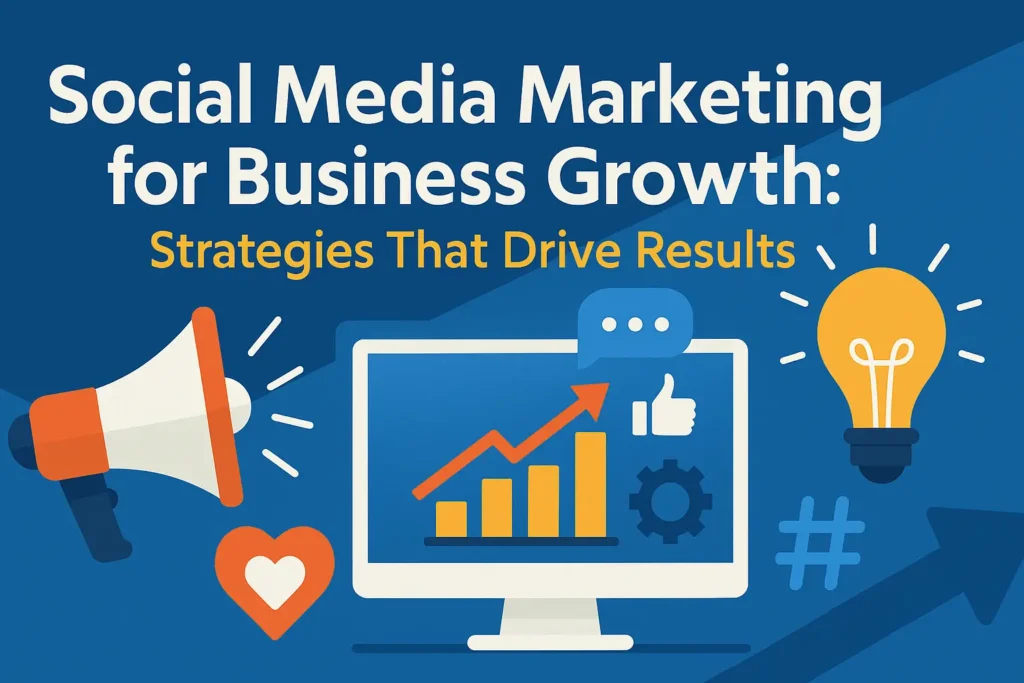Social media marketing for business growth isn’t just about likes and followers. It’s about creating meaningful connections, driving measurable results, and building a long-term competitive edge. In today’s digital-first economy, companies that ignore social platforms risk falling behind—while those who master it are scaling faster, reaching wider audiences, and turning customers into lifelong advocates.
Whether you’re a startup founder, a marketing leader at an enterprise, or an agency building brand equity for clients, understanding how social media truly drives business growth is no longer optional.
This guide will break down how to use social media strategically, with expert-backed tactics, real examples, and a growth-focused mindset.

Table of Contents
Why Social Media Matters for Business Growth
Social media isn’t just a promotional channel. It’s now a core pillar of brand presence, customer communication, and revenue generation. Here’s why:
- Global reach: Platforms like LinkedIn, Instagram, TikTok, and YouTube have billions of active users.
- Targeted marketing: Ad platforms offer precise targeting by interests, demographics, and behaviors.
- Trust and influence: 71% of consumers are more likely to buy based on social referrals or user-generated content.
- Real-time feedback: Businesses can get instant feedback on products, services, and campaigns.
- Low cost, high impact: Organic strategies like storytelling and influencer collaboration offer massive ROI without massive spend.
Choosing the Right Platforms for Business Growth
Not all platforms work equally for all brands. Choosing the right one depends on your audience, goals, and content style.
| Platform | Best For |
|---|---|
| B2B marketing, thought leadership, hiring | |
| Visual branding, influencer collaborations | |
| TikTok | Short-form storytelling, trend-driven content |
| YouTube | Long-form video, tutorials, SEO |
| Community building, retargeting ads | |
| Twitter/X | Real-time news, industry commentary |
| E-commerce, visual planning, product discovery |
Start with one or two where your ideal customer spends time. Expand once you’ve gained traction.
1. Set Smart Goals with a Growth Lens
Your social media goals must align with actual business objectives—not vanity metrics.
Instead of just “growing followers,” focus on:
- Lead generation for your service-based business
- Sales conversions for your eCommerce brand
- Customer retention via community engagement
- Brand authority through thought leadership
Use the SMART framework: Specific, Measurable, Achievable, Relevant, Time-bound.
Example:
“Generate 500 new qualified leads via LinkedIn by Q4 2025” is smarter than “increase LinkedIn presence.”
2. Create a Content Strategy That Converts
Business growth doesn’t come from random posting. You need a content strategy that attracts, educates, nurtures, and converts.
Types of content that drive results:
- Educational posts: Teach your audience something useful.
- Behind-the-scenes: Humanize your brand.
- Case studies: Show proof of success.
- UGC (User-Generated Content): Build trust through customers.
- Live videos and Q&As: Real-time engagement.
- Trends with value: Join trending conversations with insight.
Pro Tip: Use a 70-20-10 rule:
- 70% value-driven content
- 20% behind-the-scenes/humanized
- 10% promotional
Real Example:
SaaS brand Notion grew explosively by sharing community-created templates and tutorials on TikTok and YouTube.
3. Invest in Paid Social for Accelerated Reach
Organic reach is powerful, but paid social offers scale.
Start with small, test-based campaigns focused on:
- Retargeting website visitors
- Promoting lead magnets or webinars
- Boosting high-performing organic posts
- Running conversion-focused campaigns
Use Meta Ads, LinkedIn Campaign Manager, or TikTok Ads to set precise objectives. Always A/B test creatives and landing pages.
Real Example:
A Shopify store selling eco-friendly products grew revenue by 40% quarter-over-quarter through Instagram retargeting + influencer UGC ads.
4. Use Influencer & Creator Collaborations Strategically
Working with influencers isn’t just for B2C. B2B brands like HubSpot and ClickUp now collaborate with creators to educate and inspire audiences.
How to do it right:
- Micro-influencers (5K–100K) often deliver higher engagement
- Match values + audience, not just follower count
- Provide creative freedom and clear CTAs
- Track performance (referrals, traffic, conversions)
Tip: Use affiliate codes or unique landing pages to measure ROI.
5. Build Community, Not Just Audience
Business growth is about retention, not just reach. Creating community builds customer loyalty and ongoing referrals.
Tactics that work:
- Private Facebook or Slack groups for your audience
- Responding to every DM/comment (especially early on)
- Highlighting customers in content
- Hosting live AMAs, office hours, or Twitter Spaces
Real Example:
Figma built a passionate design community that scaled their product through peer evangelism—fueled by user events, tutorials, and design contests.
6. Measure What Truly Matters
Avoid being misled by impressions and likes. Track metrics that align with business outcomes:
- Conversion rate from social traffic
- Cost per lead (CPL) or customer acquisition (CAC)
- Lifetime value (LTV) of social-referred customers
- Brand sentiment or share of voice
- Audience growth rate (not total size)
Use tools like Google Analytics, Sprout Social, or native platform analytics. Always tie your KPIs to revenue or retention where possible.
7. Automate and Scale Smartly
As your strategy matures, use automation tools to scale:
- Scheduling: Buffer, Hootsuite, or Later
- Listening: Brand24, Mention
- AI content assist: ChatGPT, Jasper, Grammarly
- Analytics dashboards: Databox, Google Looker Studio
But remember: automation should support human connection, not replace it.
Final Thoughts
Social media marketing for business growth requires more than a content calendar. It demands strategy, experimentation, storytelling, and human connection. The businesses seeing real ROI today aren’t chasing followers. They’re earning trust, delivering value, and showing up with consistency.
Whether you’re a solopreneur or scaling enterprise, there’s never been a more powerful, cost-effective way to grow than by using social media with intention.
FAQs
What is social media marketing?
Which social media platform is best for B2B marketing?
How do I measure ROI from social media?
Can small businesses benefit from social media marketing?
Is paid advertising necessary for growth?
Read more: Marketing Insights
